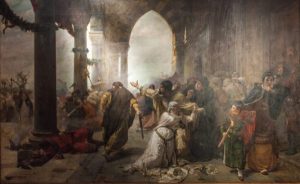Biography

EROLI Erulo, painter and arazier (Rome 1854-1916). He studied in the Roman school of San Michele a Ripa under the guidance of Ceccarini, specializing in mosaic and tapestry.
In 1875 he opened his first painter studio in Passeggiata di Ripetta. In the same year he was present for the first time with two paintings (Suonatore di tromba, Cornelio Pino Roman painter) at the annual review of the “Amateurs and Cultists” of Rome who in the following years would see him among the most assiduous exhibitors (in 1878 he won the silver medal with the painting La Baccante and the following year presents Portrait, The Offering and First Communion. In 1880 he moved the studio to the new headquarters in via del Babuino 150c, to the extension also a small but renowned tapestry workshop and the following year he participated in the National Exhibition of Fine Arts in Milan (The Tiger at the Night and the Chimney Sweep). In 1883 he was at the International Exhibition of Rome with five paintings (The Palestro cruiser in the battle of Lissa, An Arab player , A Cellarman, Portrait of Signor Jacobini, The Glory in the Choir.) Among the historical episodes, the great painting I Vespri Siciliani exhibited at the National Exhibition of Fine Arts in Pa lermo in 1892. He joined the Society of Roman Watercolorists in 1883, but his first participation dates back to 1902 with the Archangel Raffaele. Meanwhile in 1898 at the exhibition of sacred art in Turin he had won the gold medal with the Ecce Agnus Dei shovel. In 1909 he became president for three years of this partnership, which just a year earlier had found a permanent home in the Casina dell’Orologio in Villa Borghese, reforming its Articles of Association “in order to better regulate its annual exhibitions, to ensure its continuity and to offer more attractions to Fine Arts amateurs ”.
He regularly participates in the association’s annual reviews with valuable watercolors (in 1912 he presents Le sources, Resurrexit and Head Study, in 1913 Bosco and Saffo). In his maturity he worked very hard to revive the forgotten art of the Tapestries, performing valuable works for the Capitoline palaces and for the court of Romania.